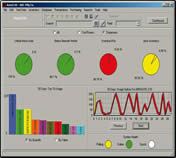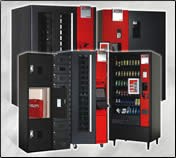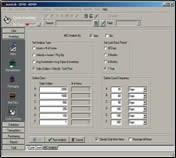How to Solve Common Inventory Management Problems Related to Tooling
A practical look at what to consider when purchasing client/server inventory management software and how to implement such a program, as well as why and how it can benefit mold manufacturing operations.
Are we out of stock? What tools and supplies were used on this job? Is it time for a cycle count? These are common questions that trigger a flurry of activity in an effort to find the correct answers. Seamless inventory control, accurate and timely reports and ease-of-use are driving automated tool dispensing systems into moldmaking shops of every size.
Used for a wide variety of tools and supplies, automated dispensing machines assist in curbing inventory costs. Often looking like an ordinary vending machine, a shop employee will walk up to the automated dispensing machine, enter his/her employee number and PIN on the keypad, and out comes not a candy bar, but a tool or item needed for the job. Inventory is adjusted and key data is captured as to what was taken, when and by whom. Reorder points are reported and stock outs are eradicated through automatic reordering directly to the supplier of that item, which in turn eliminates expensive production downtime.
Efficiencies
Moldmakers are highly skilled and often highly paid workers. It is critical they make the best use of their time. No walking across the shop, or to another building, just to stand in line to request a tool. In the U.S., the average round-trip time to the tool crib is 15 minutes. This includes standing in line, chatting with the attendant or looking for the tool themselves, and then returning to their workstation. After the installation of an automated dispensing system, the average is reduced to fewer than four minutes.
The software that works in conjunction with these dispensing machines provides accurate data on what was used for which job, who received it and what the current inventory count is for that particular item. Efficiency in inventory management reduces inventory and in turn carrying costs.
Too often shops use the peanut butter approach to job costing, taking the total cost for the month and spreading it over all jobs in house. Inventory management software provides reports for accurate job costing. No more manually assigning costs to correct job and department numbers, or utilizing the spread method. The system provides standard reports that meet most of the needs of the accounting and production department. Customized reports also are available for very specific reporting needs.
Cost Savings
With some systems offering automatic purchasing features, the manual process of purchase orders for mundane items that go into the dispensing system is eliminated. The average time/personnel cost of a purchase order is $150. With automatic purchasing, time is saved and personnel may be eliminated or reassigned to more productive tasks.
Accountability is an issue with many shops. The capacity to control waste and inventory levels is a big selling point where tight budgets and cutbacks are the norm. Typically point-of-use systems reduce overall consumption by 20 percent.
These savings come from four key areas:
- Increased accountability makes shop workers more careful of what they use and how much.
- Dispensing in the correct package quantity means less waste.
- Setting upper control limits for a specific process ensures that tools are not needlessly wasted. Supervision is forced to deal with an out-of-control process now and not when the shop has consumed every tool needed for the operation.
- A pull system of dispensing tools and supplies is a component of lean manufacturing and can reduce both inventory and the cost of ownership. Keep in mind that only about 35 percent of the cost of ownership is the purchase price of an item. The remaining 65 percent is made up of receiving, counting, storage, disposal and handling costs. With automated dispensing, many distributors will stock the machines, keep an eye on the reorders and handle disposal of used items. This is more efficient for the shop, provides significant savings and frees up personnel for more critical tasks.
A dispensing machine also forces the use of reconditioned tools and can reduce obsolescence in inventory by putting the older tools and supplies and dispensing those items first. Many shops see obsolescence reduced by half after implementing a system.
Considerations for Purchasing
There are many things to consider when purchasing an inventory management/dispensing system. Obviously the reputation of both the manufacturer and distributor will play a major role in your decision. A wide selection of dispensing machines styles and sizes will help you find the best solution for your needs.
A simple, easy-to-use interface for shop workers is key. If it is unreliable or hard to use there will be a revolt on the shop floor. The object is to make it easier for workers, not to complicate their jobs.
Interface with existing software. The system must have the ability to allow users to mine the data and get it out of the point-of-use system easily. It should also have a strong transport layer for uploading the shops ERP or back office system.
A variety of reports are usually standard. More importantly is the capability of the software vendor to either write custom reports or provide an interface that allows you to easily modify reports. Tailoring the system to specific needs in regards to defining data tracking and timing of reports is crucial. The system needs to work for you, not complicate the workflow.
Training and support also is essential. Any system will not deliver all potential cost savings if users are not properly trained and the system is not well supported.
Implementation
Making a major change in the tool dispensing and tracking procedures of a shop is not something to take lightly. There are preparations that will take some time from management. Determining the style and capacity of the dispensing machine(s) and the optimal location, is just the beginning. A review of legacy data and defining of the new database is the basis for data migration and installation. Both power and networking needs are evaluated and prepared for, as well as any other physical setup for the actual dispensing machine. Training is crucial for all those that interface with the system.
Embracing a complete system of inventory management software and tool dispensing will have an immediate impact on the shop. A smooth and well-planned implementation will make it a welcomed one.
Related Content
The Role of Social Media in Manufacturing
Charles Daniels CFO of Wepco Plastics shares insights on the role of social media in manufacturing, how to improve the “business” side of a small mold shop and continually developing culture.
Read MoreHands-on Workshop Teaches Mold Maintenance Process
Intensive workshop teaches the process of mold maintenance to help put an end to the firefighting culture of many toolrooms.
Read MoreTackling a Mold Designer Shortage
Survey findings reveal a shortage of skilled mold designers and engineers in the moldmaking community, calling for intervention through educational programs and exploration of training alternatives while seeking input from those who have addressed the issue successfully.
Read MoreLeading Mold Manufacturers Share Best Practices for Improving Efficiency
Precise Tooling Solutions, X-Cell Tool and Mold, M&M Tool and Mold, Ameritech Die & Mold, and Cavalier Tool & Manufacturing, sit down for a fast-paced Q&A focused on strategies for improving efficiencies across their operations.
Read MoreRead Next
How to Use Continuing Education to Remain Competitive in Moldmaking
Continued training helps moldmakers make tooling decisions and properly use the latest cutting tool to efficiently machine high-quality molds.
Read MoreHow to Use Strategic Planning Tools, Data to Manage the Human Side of Business
Q&A with Marion Wells, MMT EAB member and founder of Human Asset Management.
Read More





















